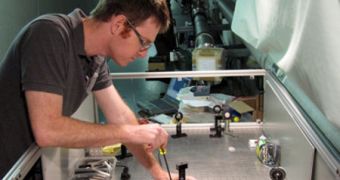One of the most interesting ideas in theoretical physics today is that our Universe may in fact by just a 3D projection of a 2D world that exists in a finite bandwidth.
Some researchers say that our existence, and that of everything around us, could be compared to a very high-definition 3D video, that unfolds within certain limits, even if very large.
This theory of the holographic Universe will be put to the test in 2011, when a new scientific instrument designed specifically to assess it will go online in Illinois, the United States.
This will be done primarily by using two of the most precise clocks in the entire world, Wired reports. However, there is a good chance that the experiments will not be successful.
What Craig Hogan, a particle astrophysicist at the Fermi National Accelerator Laboratory (Fermilab) is trying to do is use Planck units to test this idea. The problem with this is that these units are so infinitely small that they may not be experimentally observable.
Planck units deal with space, time, mass and other properties, but they are extremely small. For example, the Planck unit of length is 10 trillion trillion times smaller than an atom's proton.
But Hogan believes that this seemingly impossible barrier can be knocked down by using two precise clocks called holometers, each of which is made up of 134-foot-long, perpendicular laser interferometer beams.
These instruments are so mind-boggling precise that they can actually search for pixelation in the very fabric of space and time that keeps our Universe together.
“What we’re looking for is when the lasers lose step with each other. We’re trying to detect the smallest unit in the universe,” Hogan explains.
“This is really great fun, a sort of old-fashioned physics experiment where you don’t know what the result will be,” he adds. The basis of the experiment is to see if lasers sent from the same source reach the same target at the same time.
The expert says that the two holometers are currently being constructed at Fermilab, in Batavia, and adds that they should be ready by next years.
One interesting thing to note about this experiment is that the Planck units should become obvious within the first few minutes of operations, after environmental influences are taken out of the equation.
“We could be living inside that 3-D projection, with the truer vision of it as a 2-D sheet hidden by scale,” Hogan goes on to say.
“I think it’s a reasonable design to measure this effect, even though I think it’s unlikely he’s going to measure something. If anything happens, he’ll put to rest another exotic theory about the universe,” says Hartmut Grote.
But, if something is indeed discovered, “it would be a very strong impact to one of the most open questions in fundamental physics. It would be the first proof that space-time, the fabric of the Universe, is quantized,” he adds.
Grote holds an appointment as an experimental physicist at the Max Planck Institute, in Germany.

 14 DAY TRIAL //
14 DAY TRIAL //